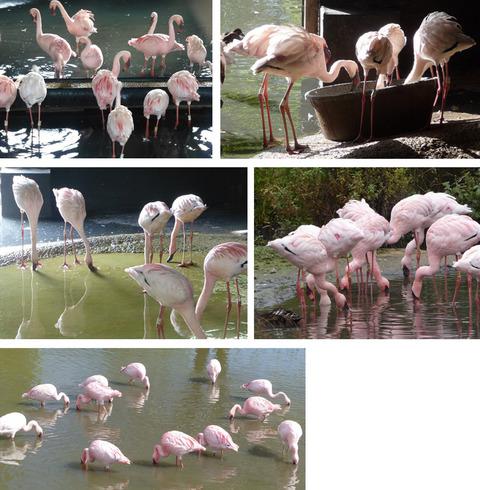Our official English website, www.x-mol.net, welcomes your
feedback! (Note: you will need to create a separate account there.)
What influences aggression and foraging activity in social birds? Measuring individual, group and environmental characteristics
Ethology ( IF 1.3 ) Pub Date : 2020-06-08 , DOI: 10.1111/eth.13067 Paul Rose 1, 2 , Laura Soole 3
Ethology ( IF 1.3 ) Pub Date : 2020-06-08 , DOI: 10.1111/eth.13067 Paul Rose 1, 2 , Laura Soole 3
Affiliation

|
For specialised feeders, accessing food resources may impact on the performance of appetitive foraging and social behaviours at individual and population levels. Flamingos are excellent examples of social species with complex, species‐specific feeding strategies. As attainment of coloured plumage depends upon intake of dietary carotenoids, and as study of free‐ranging flamingos shows that foraging is disrupted by aggression from other birds, we investigated the effect of four feeding styles on foraging and aggression in captive lesser flamingos. We evaluated individual and group differences in foraging and aggression when birds consumed bespoke “flamingo pellet” from a bowl, an indoor feeding pool and an outdoor feeding section of their pool. Natural foraging (when birds were feeding irrespective of the presence of pellet) was recorded for comparison with artificial feeding styles. One‐minute long video footage of the birds' activities in these different locations, recorded between 2013 and 2016, was used to evaluate behaviour. Total number of seconds engaged in feeding and in aggression was recorded by continuous sampling. The colour of individual birds was scored from 1 (mainly white) to 4 (mainly pink). For natural filter feeding in the outdoor pool, maximum foraging was twice as much as bowl feeding, whilst aggression was less than half as much as other feeding methods. Overall, a more restricted feeding style significantly predicted aggression, along with increasing group size. Plumage colour significantly influenced aggression (brightest flamingos were more aggressive) and showed a non‐significant trend with foraging (brighter birds fed less than paler birds). No sex effect on feeding or aggression was found. This study enhances our understanding of husbandry and species' biology impacts on captive behaviour and provides data‐based evidence to improve food presentation. For flamingos, implementation of spacious outdoor feeding areas can encourage natural foraging patterns by reducing excess aggression and enhances welfare by improving flock social stability.
中文翻译:

什么会影响社交鸟类的攻击和觅食活动?衡量个人,群体和环境特征
对于专业饲养者而言,获取食物资源可能会影响个人和人口层面上的觅食行为和社会行为。火烈鸟是具有复杂,特定物种喂养策略的社会物种的典范。由于有色羽毛的获得取决于膳食类胡萝卜素的摄入量,而自由放养的火烈鸟的研究表明,觅食会因其他鸟类的攻击而受到干扰,因此,我们研究了四种饲养方式对圈养小火烈鸟的觅食和侵略的影响。当鸟类从碗,室内饲养池和室外饲养池中消耗定制的“火烈鸟颗粒”时,我们评估了个体和群体在觅食和攻击性方面的差异。记录自然觅食(无论是否存在颗粒都喂鸟),以与人工喂养方式进行比较。2013年至2016年之间录制的一分钟长的鸟类在这些不同地点活动的录像带被用于评估行为。通过连续取样记录进食和进食的总秒数。单个鸟的颜色得分从1(主要是白色)到4(主要是粉红色)。对于室外游泳池中的自然过滤器饲喂,最大觅食量是碗饲的两倍,而侵略性则不到其他饲喂方法的一半。总体而言,更加严格的喂养方式可以显着预测其侵略性,以及群体规模的增加。羽色显着影响侵略性(最明亮的火烈鸟更具攻击性),觅食趋势不明显(较明亮的鸟食比较浅的鸟食)。未发现对进食或攻击有性别影响。这项研究增强了我们对饲养和物种对圈养行为的生物学影响的理解,并提供了基于数据的证据来改善食物的呈现。对于火烈鸟,在宽敞的户外取食区的实施可以通过减少过度攻击来鼓励自然觅食,并通过改善鸡群的社会稳定性来提高福利。生物学对圈养行为的影响,并提供基于数据的证据来改善食物的外观。对于火烈鸟,在宽敞的户外取食区的实施可以通过减少过度攻击来鼓励自然觅食,并通过改善鸡群的社会稳定性来提高福利。生物学对圈养行为的影响,并提供基于数据的证据来改善食物的外观。对于火烈鸟,在宽敞的户外取食区的实施可以通过减少过度攻击来鼓励自然觅食,并通过改善鸡群的社会稳定性来提高福利。
更新日期:2020-06-08
中文翻译:

什么会影响社交鸟类的攻击和觅食活动?衡量个人,群体和环境特征
对于专业饲养者而言,获取食物资源可能会影响个人和人口层面上的觅食行为和社会行为。火烈鸟是具有复杂,特定物种喂养策略的社会物种的典范。由于有色羽毛的获得取决于膳食类胡萝卜素的摄入量,而自由放养的火烈鸟的研究表明,觅食会因其他鸟类的攻击而受到干扰,因此,我们研究了四种饲养方式对圈养小火烈鸟的觅食和侵略的影响。当鸟类从碗,室内饲养池和室外饲养池中消耗定制的“火烈鸟颗粒”时,我们评估了个体和群体在觅食和攻击性方面的差异。记录自然觅食(无论是否存在颗粒都喂鸟),以与人工喂养方式进行比较。2013年至2016年之间录制的一分钟长的鸟类在这些不同地点活动的录像带被用于评估行为。通过连续取样记录进食和进食的总秒数。单个鸟的颜色得分从1(主要是白色)到4(主要是粉红色)。对于室外游泳池中的自然过滤器饲喂,最大觅食量是碗饲的两倍,而侵略性则不到其他饲喂方法的一半。总体而言,更加严格的喂养方式可以显着预测其侵略性,以及群体规模的增加。羽色显着影响侵略性(最明亮的火烈鸟更具攻击性),觅食趋势不明显(较明亮的鸟食比较浅的鸟食)。未发现对进食或攻击有性别影响。这项研究增强了我们对饲养和物种对圈养行为的生物学影响的理解,并提供了基于数据的证据来改善食物的呈现。对于火烈鸟,在宽敞的户外取食区的实施可以通过减少过度攻击来鼓励自然觅食,并通过改善鸡群的社会稳定性来提高福利。生物学对圈养行为的影响,并提供基于数据的证据来改善食物的外观。对于火烈鸟,在宽敞的户外取食区的实施可以通过减少过度攻击来鼓励自然觅食,并通过改善鸡群的社会稳定性来提高福利。生物学对圈养行为的影响,并提供基于数据的证据来改善食物的外观。对于火烈鸟,在宽敞的户外取食区的实施可以通过减少过度攻击来鼓励自然觅食,并通过改善鸡群的社会稳定性来提高福利。











































 京公网安备 11010802027423号
京公网安备 11010802027423号